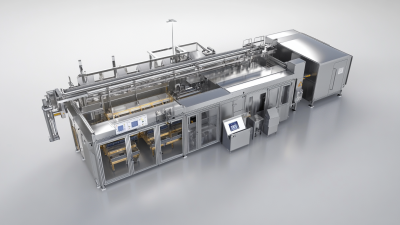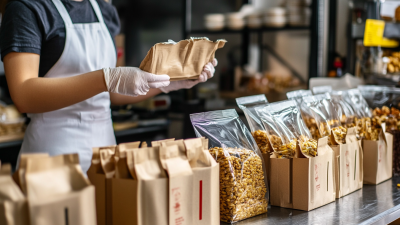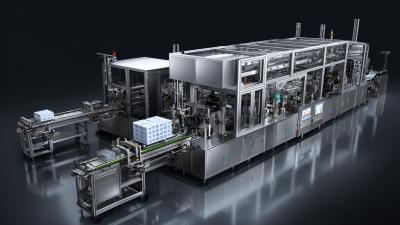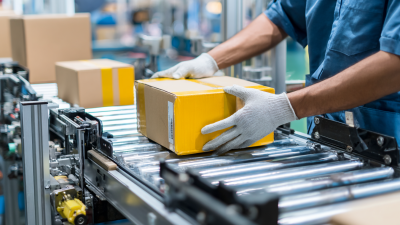A-B-C Blog
The Future of Sustainable Containers and Packaging Innovation
As the world increasingly prioritizes sustainability, the containers and packaging industry is undergoing a transformative evolution aimed at reducing environmental impact. According to a report by Grand View Research, the global sustainable packaging market is expected to reach USD 500 billion by 2027, growing at a CAGR of over 7%. This shift reflects consumer demand for eco-friendly solutions, with 74% of consumers expressing their willingness to pay more for sustainable packaging options (Nielson Global Sustainability Report). Companies are innovating across various materials and designs, from biodegradable plastics to reusable containers, to align with the growing commitment to sustainability.

Furthermore, a recent study published by Packaging Strategies indicates that about 66% of businesses plan to increase their investment in sustainable packaging solutions in the next five years, highlighting the significant momentum towards a greener future in containers and packaging. This blog will explore the current trends and future directions in sustainable containers and packaging innovation, emphasizing comparative approaches that are shaping this vital industry.
Emerging Materials: Innovations in Sustainable Container Production
 Emerging materials in sustainable container production are transforming the landscape of packaging innovation. Recent research highlights the potential of natural compounds like essential oils, plant extracts, and proteins, providing eco-friendly alternatives to traditional materials. These innovations are not only focused on functionality but also on enhancing aesthetic appeal, aligning with the growing consumer preference for sustainable products.
Emerging materials in sustainable container production are transforming the landscape of packaging innovation. Recent research highlights the potential of natural compounds like essential oils, plant extracts, and proteins, providing eco-friendly alternatives to traditional materials. These innovations are not only focused on functionality but also on enhancing aesthetic appeal, aligning with the growing consumer preference for sustainable products.
To further drive this evolution, adopting a design perspective is essential. This involves promoting materials linked to the circular economy and environmental sustainability, ensuring that packaging is not only recyclable but also made from renewable resources. The continuous transition towards biopolymer-based solutions, inspired by recent projects, emphasizes the importance of home-compostable materials.
Tips for businesses looking to embrace sustainable packaging innovations include researching and integrating biodegradable materials into product designs, collaborating with suppliers specializing in eco-friendly options, and staying informed about emerging trends in materials technology. By prioritizing sustainability, companies can cater to environmentally-conscious consumers while actively contributing to a healthier planet.
Biodegradable Options: Redefining Packaging with Nature in Mind
As the demand for sustainable solutions grows,
biodegradable packaging options are emerging as a transformative force in the industry.
Traditional packaging materials, often derived from petroleum, contribute significantly to environmental pollution
and landfill waste. In contrast, biodegradable materials
are designed to break down through natural processes, significantly reducing their environmental footprint.
Innovations in plant-based plastics and compostable packaging are gaining traction, offering brands an opportunity
to align their products with eco-conscious consumer behavior while protecting the planet’s resources.
The shift towards biodegradable packaging is not just an eco-friendly trend; it represents a fundamental
rethinking of how we approach consumption and waste. By prioritizing materials that return to the earth,
brands are redefining their roles in the lifecycle of products. For instance, packaging made from
cornstarch or
mushroom-based materials not only biodegrades
but can also offset carbon emissions and reduce reliance on fossil fuels. As more companies embrace
these innovative solutions, it creates a ripple effect, encouraging competitors to follow suit and
consumers to demand more sustainable options in their purchasing decisions.
Circular Economy: Designing Containers for Reusability and Recycling
As the world shifts towards a more sustainable future, the concept of a circular economy is becoming increasingly vital in the design of containers and packaging. This innovative approach emphasizes the importance of creating products that are not only recyclable but also reusable, significantly minimizing waste and the environmental footprint. By prioritizing design for longevity and adaptability, companies can ensure that their containers serve multiple life cycles, moving from one use to another seamlessly.

To achieve effective circularity, manufacturers must focus on materials that are both sustainable and conducive to recycling. Biodegradable plastics, glass, and metal are at the forefront, offering the resilience needed for repeated use while being readily processed at the end of their life. Furthermore, incorporating user-friendly features into container design—such as modular components or easy disassembly—can facilitate recycling efforts, making it simpler for consumers to participate in eco-friendly practices. By embracing these principles, businesses not only contribute to a greener planet but also meet the growing consumer demand for responsible and sustainable products.
Smart Packaging Solutions: Technology in Sustainable Container Design
The demand for smart packaging solutions in the sustainable containers and packaging sector is rapidly evolving. As consumers become more environmentally conscious, the pet food packaging market is adapting to incorporate innovative materials and designs. By focusing on sustainability, companies are not only enhancing their product offerings but also addressing significant market segments, including types of packaging like bags, boxes, and cans. With an increasing emphasis on renewable resources, manufacturers are exploring biodegradable plastics, recycled paper, and recyclable metals to minimize environmental impact.
When considering temperature-controlled packaging, it's crucial to recognize how this technology can enhance product shelf life and quality. The market for temperature-controlled solutions is projected to grow, with innovations in active and passive packaging providing better preservation for sensitive items. Companies should also consider child-resistant features and re-sealable designs to ensure product safety and convenience for consumers.
**Tips:**
1. Consider utilizing biodegradable materials in your packaging solutions to enhance sustainability and attract eco-conscious consumers.
2. When designing temperature-controlled packaging, prioritize insulation and protective features to minimize spoilage and ensure product integrity during transport.
The Future of Sustainable Containers and Packaging Innovation
This chart illustrates the projected growth of various sustainable packaging solutions over the next five years, highlighting the increasing adoption of smart packaging technologies.
Consumer Trends: Shifting Perceptions Towards Eco-Friendly Packaging Choices
As consumer awareness about environmental issues continues to rise, there is a noticeable shift in perceptions towards eco-friendly packaging. Today’s consumers are increasingly informed and concerned about the lifecycle of the products they purchase, from sourcing to disposal. This has sparked a demand for sustainable containers that not only minimize ecological impact but also communicate a brand's commitment to environmental stewardship. Brands that embrace this shift can enhance their market appeal while contributing positively to the planet.
Innovations in sustainable packaging are emerging across various industries. For instance, biodegradable materials, recycled post-consumer plastics, and reusable packaging systems are gaining traction. Companies are exploring creative ways to use materials like mushroom mycelium and seaweed, which provide both functional and aesthetic advantages. By implementing these sustainable alternatives, brands are not only responding to consumer demand but also fostering loyalty among environmentally-conscious shoppers who prioritize sustainability in their purchasing decisions. As this trend continues to evolve, businesses must remain vigilant and innovative to stay ahead in the competitive landscape of eco-friendly packaging.
The Future of Sustainable Containers and Packaging Innovation - Consumer Trends: Shifting Perceptions Towards Eco-Friendly Packaging Choices
| Consumer Demographic | Preference for Eco-Friendly Packaging (%) | Awareness of Environmental Impact (%) | Willingness to Pay Extra (%) | Favorite Material Types |
|---|---|---|---|---|
| 18-24 Years | 78% | 65% | 55% | Biodegradable Plastics, Recycled Paper |
| 25-34 Years | 82% | 70% | 60% | Glass, Metal, Compostable Materials |
| 35-44 Years | 75% | 68% | 50% | Cardboard, Eco-Friendly Plastics |
| 45-54 Years | 70% | 64% | 45% | Recyclable Plastics, Glass |
| 55+ Years | 68% | 60% | 40% | Recyclable Cardboard, Eco-Friendly Plastics |
Related Posts
-

Mastering the Art of Containers and Packaging Strategies for Sustainable Business Growth
-

Innovative Options for Food Packaging Equipment That Transform Your Production Line
-

Exploring Innovations in Package Machine Design with 2023 Industry Trends and Data
-

Navigating Global Standards for Food Packaging Machines: A Comprehensive Guide to Export Certification
-

Elevating Global Standards with Best Package Machine from China
-

Finding Quality Suppliers for Best Wrap Around Case Packers Essential Checklist for Global Buyers






